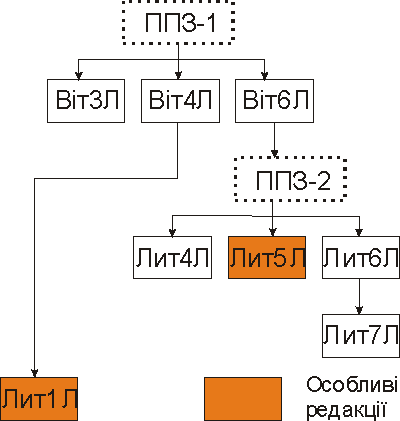Analysis variants
Nicholas Zharkikh
Shortened text of the section. Full text in ukrainian version
Dependence of copies
Of all the above arguments imply the following stemma TPL:

Stemma "Tale of Podillja land"
Place the story in the annals
Editions of the tale
The purpose of the product
Evaluation of the source value
Now we can answer the questions "Profile historical source»:
1. When the text written? – Shortly after the death of Vytautas, in the 1430s; perhaps even in 1431 (does not reflect any events subsequent armed struggle for Podillja).
2. Which historical period covers the text? – The last 90 years before writing, 1341 – 1430.
3. Where the text written? – At the Wilno as the capital of the Grand Duchy of Lithuania.
4. Which geographical area covers the text? – The territory of Podillja, partially – present-day Belarus.
5. What are the sources used in the preparation of the text? – I can not see the traces of written sources; it can be assumed that the description of the campaign Vytautas (29 – 39) is withdrawn from the "Acts of Vytautas" and moved here.
6. As far as the author was competent in matters about which he wrote? – Undoubted competence of the author in the event since occupation of Podillja by Vytautas (1394). The introductory part, which covers the time of Algirdas, built on the recollection and conjecture.
7. What was the purpose of writing the text? – Justification of the rights Grand Duchy of Lithuania on the Podillja.
8. What are the sources of the processing methods used the author to achieve his goal? – Emphasizing the independence of the Lithuanian princes actions during the occupation of Podillja (lack of outside help, in particular, Polish).
9. What are the structural parts of the text is? – No structural parts, the story is monolite and written in one step.
From these responses should be our general dual assessment "Tale of Podillja land" as an important historical source for the events late 14th – first third of the 15th century, and a fabulous story about ancient events. This conclusion follows practical recommendations: for historical research should be used Vit4L text only, complementing the best readings of Vit3L and Vit6L. The texts of the later copies systematically deteriorate, and one should not use them.
